Measuring Success in Conservation
By Leah Gerber, Douglas DeMaster, Simona Roberts
Assessing efforts to restore populations of marine mammals is partly a matter of epistemology: How do you know when enough is enough?
Assessing efforts to restore populations of marine mammals is partly a matter of epistemology: How do you know when enough is enough?

DOI: 10.1511/2000.29.316
Ecological consciousness has been rising in the United States and Europe over the past 30 years, making people more aware of their guardianship of the earth's natural resources. In the recent past, several projects have been launched to catalogue all living species in an attempt to protect them from extinction. But this sense of protectionism is not applied evenly to all species.
Every year, populations of plants, insects and even microbes reach the brink of extinction, virtually unnoticed. In the meantime, the threat of large-mammal extinctions arouses public passions, attention and, ultimately, money. It is here, at the intersection of sentimentality and scientific controversy that conservation biologists typically face their greatest challenge.
This challenge is twofold. First, biologists need to determine which populations really need recovery action, and just as important, we need to know when a population no longer requires our intervention. Clearly, the efficiency with which these are done can have important economic consequences. Inefficient assessment of conservation activities can lead to economic inequities. It can lead groups to spend money on animal populations that have recovered at the expense of other, lesser known, and possibly less photogenic species that actually need the help. In short, a well-defined ecological policy could translate into sound economic policy as well. Yet putting sound conservation policies into place is hardly straightforward.
The Endangered Species Conservation Act (ESCA) of 1969 and its 1973 iteration, the Endangered Species Act (ESA), defined categories for endangered and threatened species but provided no criteria for deciding when a species should be listed, delisted or "downlisted" from endangered to threatened. As a result, listing and recovery actions for marine mammals, as well as other species, are widely inconsistent. The ESA was amended in 1988 to require that recovery plans include specific criteria to determine when a species should be removed from the List of Endangered and Threatened Wildlife. Nevertheless, our own work with whales has shown this to be a rather sticky epistemological problem. We are barely at the point that we can determine with any kind of certainty when a population has recovered. Recognizing this, we have been working to solve this problem for several populations of endangered whales with the hope that it will move us into a time where rigorous data collection and analysis, and not sentimentality, drive conservation policy.
Among the most widely recognized "poster species" for conservation, whales were also among the first species to be listed as endangered under the ESA. There were eight species of large whales classified as endangered under U.S. law in 1973, including the blue, fin, sei, humpback, right, bowhead, gray and sperm whales. All of these were severely depleted by commercial whaling. The first seven of these species are baleen whales; and the eighth, the sperm whale, is a member of the suborder of cetaceans known as the odontocetes, or toothed whales.
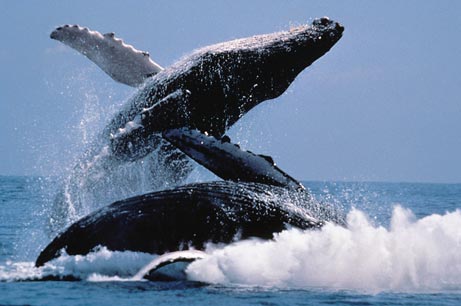
The Atlantic gray whale is the only population of large whale believed to have gone extinct in recent history. However, it is still debated in the scientific community whether this population's fate was caused by overhunting or was instead the consequence of significant oceanographic changes. Little is known about these whales. Whaling records and sub-fossil specimens indicate that this population was present up to at least the 17th century. Although it is too late to be successful in our management of the North Atlantic gray whale population, it is not too late to promote the recovery of the 40-plus existing populations of large whales in the world's oceans. So, naturally, we would like to know how well conservation policy for recovery of large whales has been working in recent years.
Scientists, policy makers and the general public are equally concerned about the survival of large whales, especially in the wake of three relatively recent events. First, eight large whale species were listed as endangered following growing concerns about overharvesting by commercial whaling operations of the last century.
Second, management within the U.S. by the National Marine Fisheries Service (NMFS) and internationally by the International Whaling Commission (IWC) has changed from a genus- or species-specific orientation to a population-specific orientation (a subspecies group whose individual members do not interbreed with individuals from other populations). This approach to management has not only been adopted in the case of large whale species but has, for the most part, also been adopted by all regulatory agencies responsible for the management of renewable resources. In recognizing that particular populations might be threatened even if the entire species is not, management has become considerably more successful at conserving biodiversity. What this means is that it is no longer appropriate to talk about the status of large whale "species." Rather, one should refer to the status of a particular population of a whale species.Third, the IWC approved a moratorium against all commercial whaling beginning in 1985 for some populations of large whales and in 1986 for all remaining large whale populations. This moratorium remains in force today with an exception which was formally requested by Norway for commercial harvest of North Atlantic minke whales, which are not listed as endangered under the ESA.
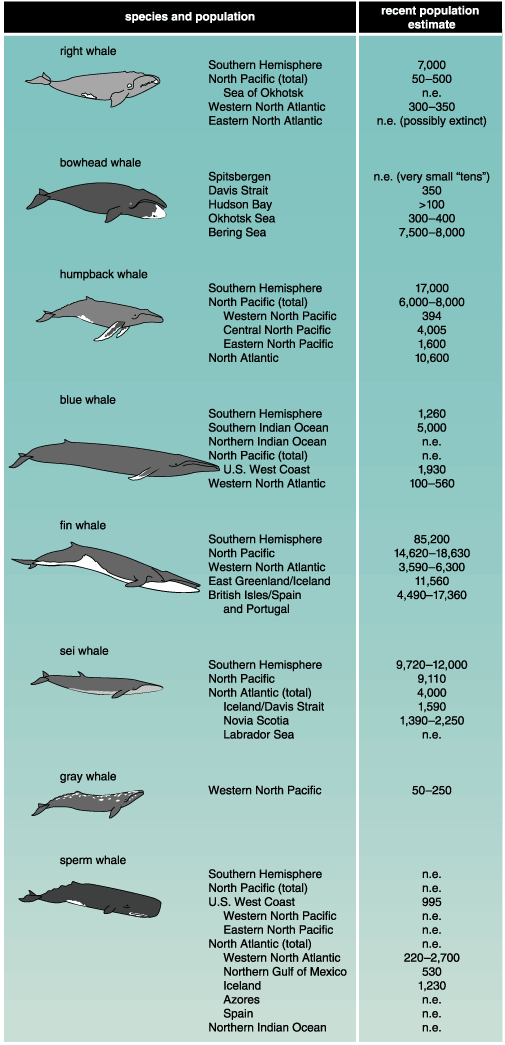
Barbara Aulicino
In addition, considerable research on population abundance, population structure and trends in abundance has been carried out since the late 1960s. Most species of large whales are extremely difficult and expensive to study because they must be surveyed from large, ocean-going research vessels. However, a number of species can be found, at least seasonally, along coastlines during their migrations or during breeding and feeding seasons. We know the most about these coastal populations of right, gray, bowhead, and humpback whales. Current estimates of population sizes for large whales listed as endangered range from 17,000 humpbacks in the Southern Hemisphere to fewer than 350 for Northern right whales in the western North Atlantic. Although considerable progress has been made, population structure within species is only relatively well understood for a few species, including bowhead and gray whales. Understanding population structure is clearly one of the most important research areas before us in the next decade.
In some cases, there are data suggesting that we are doing a good job recovering whales from the brink of extinction. Adequate information on trends in abundance is available for only 12 populations of large whales, but 10 of these have been increasing in number since the early 1990s. Of particular interest is the recovery, or significant progress towards recovery, of the eastern North Pacific population of gray whales and the western Arctic population of bowhead whales in the presence of aboriginal subsistence harvest.
The mere fact that several populations are increasing does not indicate that they are truly on the road to recovery. First, uncertainty surrounding historic and current population estimates for all species makes it difficult to know with confidence the extent to which populations of large whales have "recovered." More generally, there is the sticky problem of defining recovery in an unambiguous manner. In fact, no management agency has come up with a rigorous and objective definition for it. Nowhere in the ESA are there criteria presented to define recovery. Although the conservation biology community and the World Conservation Union—IUCN—have recently made considerable progress in developing methods for classifying the degree to which a population is vulnerable to extinction, many of these criteria are not easily adapted to marine species. It should also be noted that in none of the existing National Marine Fisheries Service Recovery Plans for large whale populations have adequate classification criteria been reported.
For the most part, our limited knowledge of large whale biology makes it extremely difficult to quantify the degree to which a population may go extinct in a specific period of time. There are numerous problems and difficulties in estimating population parameters for large whales over an entire ocean basin and in deciphering accurate data from inaccurate historical catch records. Without this information, it is generally impossible to predict extinction events.
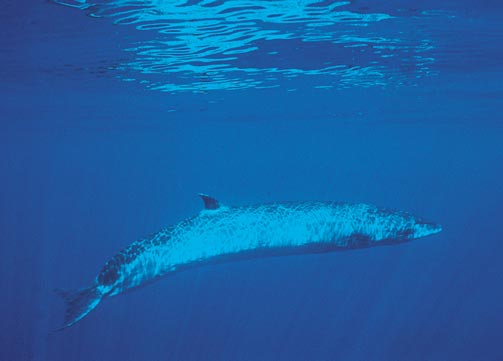
Animals Animals, James Watt
For several species of large whales there is even insufficient information about population structure and abundance to make determinations regarding their ESA status. These include fin, sei and sperm whales.
Unfortunately the public and the press have not been entirely aware of these difficulties. Worse, advocacy groups on both sides of the environmental continuum and even some scientists have filled this void with inaccuracies. Many references indicate that sperm whales are no longer in danger of extinction. In truth, we do not have enough basic population data to say how healthy sperm whale populations are. Equally troubling is the public perception that all "species" of "whales" are likely to go extinct within the next decade. Indeed, a Gallup poll conducted in 1992 revealed that citizens of America, Australia, England, Germany, Japan and Norway have very limited knowledge about the status of large whales.
On the other hand, there is adequate information to at least begin assessing some populations of large whales, including bowhead, gray, humpback and right whales. Some of these populations are showing signs of recovery. The most notable of these is the eastern North Pacific population of gray whale. This population was removed from the ESA List of Endangered and Threatened Wildlife in June 1994. The population size is currently estimated at 26,635 reflecting an annual increase of approximately 2.5 percent between 1968 and 1998. In addition, the western North Atlantic, eastern North Pacific, and central North Pacific populations of humpback whales are all relatively large and are thought to be increasing. Recent reports also suggest that populations of humpback whales in some areas of the Southern Hemisphere are recovering, as is the western Arctic bowhead population.
As we gather more information about the size and structure of these populations and we enact measures to reduce human impacts on them, such populations may be considered for downlisting or delisting. Of course, this assumes that sometime in the future investigators will have obtained enough population information to develop objective criteria for recovery and that these criteria will be adopted either generically for large whales or on a case-specific basis.
Blue-whale populations on the West Coast of North America are also showing signs of growth. The population in the waters off California, Oregon and Washington is estimated at 1,927. Although additional data are still necessary on population structure, trends in abundance and habitat requirements, this population may also soon be a candidate for downlisting. In addition, some populations of right whales in the Southern Hemisphere are known to be increasing. Although still small relative to their pre-exploitation populations, these increases in abundance for southern right whales are encouraging.
Unfortunately, there are also data indicating that several populations of large whales are in danger of extinction. Their populations are already greatly diminished and they remain threatened by human activities. These endangered species include all populations of the northern right whale, the eastern Arctic and Okhotsk Sea populations of bowhead whales, the western North Pacific population of gray whales and several populations of blue whales.
Measures of population size provide only a superficial view of the success of recent efforts to boost whale populations. To truly appreciate what actions appear to have worked, and what constraints seem to be frustrating our conservation efforts, we need to look in detail at some case studies. We focus here on three populations of large whales that range from being perilously close to extinction in spite of vigorous protective actions to a population of whales that has recently performed so well that it was delisted.
The North Atlantic and North Pacific populations of the right whale (Eubalaena glacialis glacialis) are among the most imperiled populations of baleen whale in the world. These highly migratory whales congregate in continental shelf waters where their distribution is strongly correlated with that of their zooplankton prey. In the western North Atlantic, right whales calve from January through March in near-shore waters of the southeastern U. S. and migrate north to feed in the late spring. Feeding aggregations are found from the Great South Channel to the Bay of Fundy and northward from May through December. Although there is no reliable abundance estimate for the eastern North Pacific population of right whales, there is little doubt that the population is likely to include no more than a few hundred animals at best.
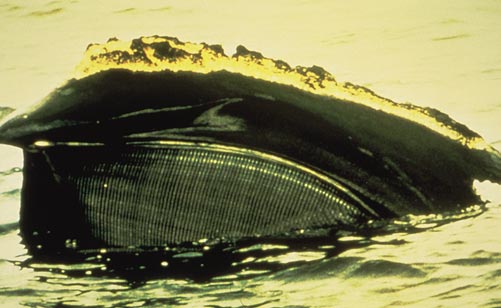
Photograph from the National Marine Mammal Whale Collection, courtesy of Gerber
Aerial and vessel surveys for right whales in the southeast Bering Sea have been conducted in the past three years, but only a handful of individuals has been seen in total, none of which were young of the year. Despite this extensive research, conservation biologists still do not know where the breeding population is located during winter. In fact, young of the year for the North Pacific right whale population have not been observed in this century!
This population has been officially protected from commercial whaling since 1935. However, the former Soviet Union never ratified the agreement, and apparently right whale numbers in the eastern and western North Pacific were greatly reduced as a result of Soviet catches well into the 1960s. Data recently presented to the IWC indicate that Russian whalers might have illegally harvested this population until 1971. Whether this population can recover from such extremely low numbers cannot be predicted at present. For that reason, as well as to provide information needed to promote recovery, it is very important to continue monitoring this population over the next few decades.
The western North Atlantic right whales have been researched extensively. This population is currently estimated to contain only 300 to 350 individuals and continues to be threatened by entanglement and ship strikes. At this size, there is concern about social dysfunction and failure to simply find a mate and reproduce successfully.
In population biology, the phenomenon of reproductive failure as a result of low population density is known as the Allee effect. There is continuing debate among whale biologists over whether or not an Allee effect is actually a factor preventing the northern right whale from recovering because there are continued threats—entanglement and ship strikes—that may be impeding recovery.
While scientists continue to debate the specific reason or combination of reasons for the northern right whale's plight, states along the U.S. Atlantic seaboard have begun to address the human-related impacts. The existing threats to this population involve ship strikes during the feeding season in spring, summer and fall, ship strikes in southeastern U.S. shipping lanes during the calving season in the winter and fishing-gear entanglements throughout the year.
A further complication comes from the fact that the wintering areas for 85 percent of the western North Atlantic right whale population remain a mystery. To reduce human collisions with whales, monitoring and warning systems have been installed in calving grounds off of Georgia and Florida. There have also been fishing closures and gear modifications to reduce the impact of fishing activities on right whales in the western North Atlantic.
In spite of these efforts, the western North Atlantic right whale has shown no sign of recovery or at least no substantial population growth in the last two decades. The problem is especially challenging because even if there were perfect information, political will and unlimited resources, it might not be possible to adopt any single action that would immediately increase the population growth rate of the northern right whale.
Bowhead whales (Balaena mysticetus) of the western Arctic are the only one of the world's five bowhead whale populations to apparently recover since the end of commercial harvests in the late 19th century. This population is widely distributed in the central and western Bering Sea in the winter and at this time is typically associated with the marginal ice fronts or polynas found near St. Matthew and St. Lawrence Islands and the Gulf of Anadyr.
During the spring, bowheads leave the Bering Sea and migrate north and east through the eastern Chukchi Sea into the Beaufort Sea. Most of the bowhead whales in this population range throughout the Beaufort Sea during summer months to feed on euphausiids and small copepods. In the late summer and early fall, bowhead whales from this population migrate westward out of the Beaufort Sea. When these animals reach the Siberian coast, they follow coastal waters southeast through the Bering Strait and into the Bering Sea, where they overwinter.
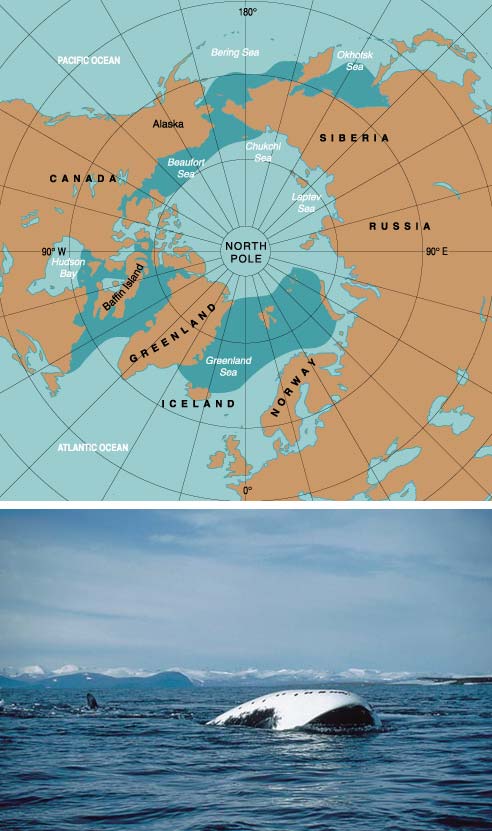
This population has recovered to 8,000 animals as of 1993, which represents somewhere between 30 and 80 percent of its pre-exploitation abundance. Since bowhead whales are one of the primary sources of protein for high Arctic communities, they have continued to be harvested, under the management of the IWC, by Alaska native subsistence hunters.
Despite their continued harvest, the western Arctic population is recovering, whereas the other four unharvested populations are not. As long as the status of the western Arctic bowhead whale continues to improve and the subsistence harvest continues to be monitored internationally, this population could be a candidate for downlisting.
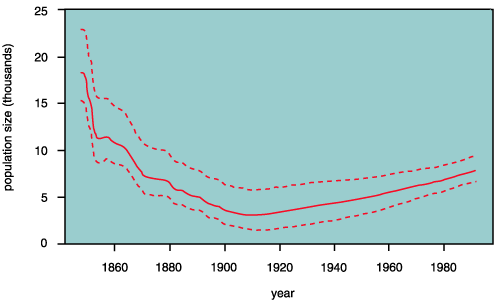
Tom Dunne and Lil Chappell
The eastern North Pacific gray whale (Eschrichtius robustus) was one of the first species to be removed from the ESA List of Endangered and Threatened Wildlife and is the only large whale to have been delisted. Despite the unusually long time series of data indicating a growing population that already exceeds 20,000 animals in the wild, the decision to delist was especially contentious. Eastern North Pacific gray whales, which breed along the West Coast of North America and follow an annual migration pattern from Baja California to Alaska, were severely depleted by commercial whaling, reaching their lowest point of about 4,000 in the late 1980s. Population counts of the eastern North Pacific gray whale have been taken 19 times over the last 30 years. These surveys and other data indicate that since its international protection in 1946, the population has recovered to a level near its estimated pre-exploitation size to its current size of approximately 26,600 individuals. This population appears to be increasing still.
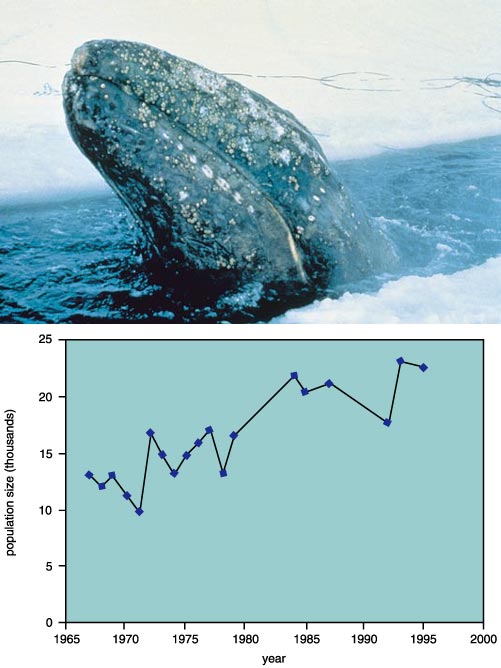
Much like the western Arctic population of bowhead whale, the eastern North Pacific gray whale has increased in numbers over the past few decades while undergoing a harvest by native subsistence hunters. The IWC has agreed to allow permits for harvesting only by aborigines or a contracting government on behalf of aborigines, and only when the meat and products of such whales are to be used exclusively for local consumption by the aborigines whose traditional subsistence and cultural needs have been recognized. Similar to the restrictions on bowhead whale harvesting, this quota does not allow hunting of calves or any gray whale accompanied by a calf.
To address the question of how much monitoring is necessary to detect recovery of the eastern North Pacific gray whale population, we sampled different sets of data from the 19 years of abundance estimates in order to identify the minimum number of years of data required to make the decision to remove the population from the ESA. Great care was taken to select all possible combinations of consecutive abundance estimates for any given duration of monitoring. We then applied a model to determine ESA status for each subset of survey data and found that a quantitative decision to delist is unambiguously supported by 11 years of data, but precariously uncertain with fewer than 10 years of data.
The data needed to produce an unequivocal decision to delist gray whales cost the National Marine Fisheries Service an estimated $660,000, a surprisingly modest expense given the fact that delisting can greatly simplify regulatory constraints. This example highlights the value of population monitoring in administering the ESA, and provides a compelling example of the utility of such information in identifying both imperiled species and recovered species. The economic value of such data should be clear: They provide the foundation for making appropriate delisting decisions that could ultimately save much more money than the collection of the data would ever cost.
All populations of large whales currently listed as endangered under the ESA were severely depleted, or threatened with severe depletion, as a result of commercial whaling. Commercial whaling of these species ended sometime between the 1930s and the 1980s. The first and simplest test regarding the successful conservation of endangered populations of large whales is whether all of these populations have fully recovered; that is, whether they are no longer in danger of extinction. The answer is "no." Only the eastern North Pacific population of gray whales seems to have fully recovered.
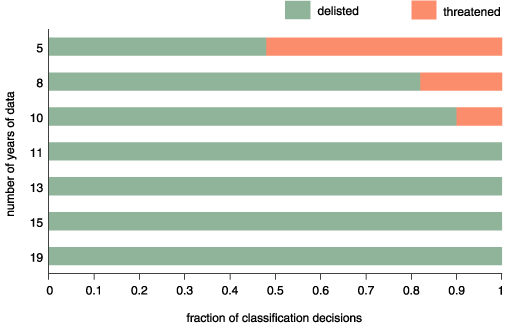
Tom Dunne
Although a majority of populations for which we have data are reported to be increasing, there are several notable failures, including all populations of the northern right whale, eastern Arctic and Okhotsk Sea populations of bowhead whales, the western North Pacific population of gray whales and several populations of blue whales. For some of these populations, illegal commercial whaling in the late 1960s and early 1970s is certainly a key factor in preventing recovery. On the other hand, the western North Atlantic population of right whales has not been illegally harvested, yet it still fails to recover.
Fishery interactions and ship-strikes may contribute to the persistent failure of populations to expand, but there may be a more important factor. It may be that when large whale populations become "too small" (yet to be defined), they will not recover. It is crucial in the future that this lesson not be ignored. The good news for these populations is that none has become extirpated in the last 25 years, although their current status is perilous at best.
Even if many populations have failed the full test of successful conservation, are they at least on their way toward recovery? Clearly, any evaluation of recovery using quantitative criteria is hampered by our limited knowledge of population structure within a species, as well as our lack of information on abundance and trends in abundance. Nevertheless, significant recovery has been reported for several populations of humpback whale in the North Atlantic and Southern Hemisphere, right whales in the Southern Hemisphere, blue whales off the West Coast of the U.S., and the western-Arctic population of bowhead whales. In addition, several other populations seem to have reached relatively high abundances, but trends in abundance and population structure are unknown. These include populations of North Atlantic fin whale, North Pacific fin whale and North and South Pacific sperm whale. Thus it looks like a majority of populations for which we have adequate information to evaluate recovery are indeed recovering.
The lesson here seems to be that at least some large whale populations can recover from overexploitation, but only if their numbers are not reduced to some level, beyond which the "extinction vortex" reaches out and starts pulling them inexorably towards extinction. To ensure that such low population levels do not occur, we recommend that human-related mortalities be limited to something under 2 percent of a conservative estimate of abundance per year. This level of mortality is considered sustainable based on our understanding of basic large-whale biology and the potential for recovery from stochastic events.
Another lesson from this approach is that moratoria on harvest alone are insufficient to guarantee adequate conservation. Without adequate monitoring, it is not clear to what extent management objectives have been or will be achieved. Adequate monitoring programs, such as that for the eastern North Pacific gray whale, will not be inexpensive and will not be brief.

Photograph by Jim Darling
A related question is why some populations are recovering while others are not. Two lessons may be derived from our case studies regarding this question. First, despite the over 60-year moratorium on the harvest of right whales worldwide, there are several recovering populations in the Southern Hemisphere, whereas Northern Hemisphere populations continue to be in danger of extinction. Second, despite the continued harvest of bowhead whales in the western Arctic, this population is recovering, whereas the other four unharvested populations are not. The western Arctic and Southern Hemisphere may be distinguished by a comparatively low amount of human activity on the margins of the oceans as compared with the rest of the world's oceans. We therefore speculate that the lack of recovery in some populations may be slowed by non-harvest impacts such as fishery-gear entanglement or ship collisions. Furthermore, in some ocean basins significant oceanographic changes may have taken place. However, without long-term monitoring studies on habitat use, trends in abundance and feeding ecology, it will not be possible to ascertain why certain populations of large whales are recovering, while others are not. As the 20th century comes to a close, the threat of large-whale depletion at the hands of commercial whalers is no longer imminent. Today indirect effects from human activities such as shipping, fishing, pollution, habitat degradation and mineral exploration are the primary threats facing large whales. Although it is still important to consider any lingering effects of direct over-exploitation, it is also time to focus on what dangers—whether human or environmentally driven—these animals are currently facing and how these dangers may influence their continued survival.
For several populations of large whales, the current status under the ESA needs to be reconsidered. In developing ESA classification schemes for populations, such as the North Atlantic humpback whale and the western Arctic bowhead whale, decision makers will be hard pressed to develop and use an objective set of criteria for all populations of large whales. Yet such objective criteria are exactly what are needed when agencies are faced with an emotionally charged public, a lack of biological data and a clear need to set priorities for allocating limited resources.
Click "American Scientist" to access home page
American Scientist Comments and Discussion
To discuss our articles or comment on them, please share them and tag American Scientist on social media platforms. Here are links to our profiles on Twitter, Facebook, and LinkedIn.
If we re-share your post, we will moderate comments/discussion following our comments policy.